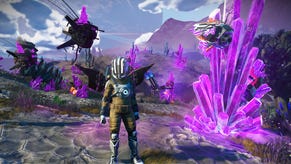How No Man's Sky uses the power of Xbox One X
And how well does the standard console compare?
No Man's Sky's latest 'Next' update is the deepest reinvention of the game to date. In terms of the improved rendering tech, the addition of a third person camera, a long-awaited multiplayer mode, upgraded base building, and much more - we've come a very long way since the its original PS4 launch. Indeed, this isn't just No Man's Sky's biggest update so far but also a landmark release for Xbox One and Xbox One X, with users of Microsoft console hardware finally able to enjoy this fascinating game.
The increase in install size compared to its launch on PS4 is telling. Back in 2016, No Man's Sky had a tiny 3GB footprint - a factor of the game's procedural generation of locations and artwork, but today's fully updated Next edition brings us closer to 8GB on Xbox One, with users of Microsoft's console getting all of the new updates and benefits in one package at release. And while it's difficult to show the exact before and after of visual upgrades, the promise here is of improved terrain generation, lighting, draw distances, better atmospheric effects, higher quality textures, water shaders, new sound effects - plus a third-person camera option.
The new camera mode stands out immediately, and it's the default for anyone starting a new game. This has its pros and cons, but it does a great job of giving you a sense of perspective in a large spatial playground. A detailed, polygonal character is rendered on-screen, where animations are surprisingly varied. It looks great: every step, every type of incline, is factored in - meaning a steep hillside triggers a sideways trot, while flatlands can be navigated at a sprint. One frustration here is the way the camera orbits behind, only loosely attached to the player's movement. It sways left to right constantly, and never fixes on the subject - making aiming the target reticle harder than in the first-person view.
It's perhaps a triumph of style over function, but it's undeniably a neat extra, and can be undone with a simple toggle if you'd prefer. No Man's Sky's strength has always been to show your relative size in a universe, and having an avatar in third-person does help to illustrate that scale. Equally, the base building is vastly expanded to highlight the very same thing. Through a redesigned tutorial, you're encouraged to build a base using smaller blocks before a storm kicks off - walls, ceiling, doorways, and a swathe of other parts assigned to pushing up on the d-pad. All of this is far more flexible on the Next update, letting you even build towards bodies of water if you'd prefer.
In many ways it's the version we've waited two years for. Factor in the multiplayer - available from the start - and it's now possible to build, fight, race, or explore planets as a team. Inadvertently perhaps, this changes the tone of the game from what we played at launch. The original release succeeded in making you feel alone in the universe, a sole traveller dislocated from the rest of civilisation. But with this Next update, the goal shifts towards finding others, in order to show off what you've built or the planets you've found. Obviously, there is still value to playing purely on your own - and that's very much kept in place.
Improved draw distance is another key upgrade. The game continues to use procedurally generated terrain - laying the tracks ahead of the player just before they get to it. With Xbox One X as the first version we booted up, pop-in isn't as obvious as it was on a base PS4 at launch. Looking back, mountains and trees were prone to fizzling into view only just ahead of the camera on Sony's machine, especially while in flight. While there are still signs of terrain fading in on the Next upgrade with X, it's hidden more effectively, and other new visual features are added to the mix.
For example, cloud simulation is a brand new variables added to each planet, letting projected shade pass across the ground. Pick the right planet, and the atmosphere is as such that it'll also speed up based on properties for wind - creating a surreal pulse between light and dark. It's a standout extra in the Next upgrade, and weaves in beautifully with the existing snow, and rain effects - and lighting stays consistent with the day-night cycle that governs every planet. The only drawback to this is the clouds themselves: these render at a low resolution, almost as if a higher quality asset is waiting to pop in. Hopefully this isn't the final intended effect, because everything else around it holds up.
Elsewhere, you keep all of the great legacy effects No Man's Sky's built up over the years: the motion blur, temporal anti-aliasing, and even post-effects like depth of field across the distance stand out. It gives the game an aura of a high-budget title at a distance, even if up close the building blocks of the world are easy to spot in some muddy texture-work. That's all there right from launch for Xbox One users, and the same goes for the elegant light shaft effect added in the Pathfinder update. Looking back, there were a lot of challenges for Hello Games to overcome - and this effect originally didn't work on PS4. Here, everything is in place and working wonderfully.
Moving the code from PS4 to Xbox One consoles has clearly been a long time coming though, so it's interesting to see how S and X machines stack up today. The base console delivers a native 1600x900, up against the standard PS4's 1080p - though image quality still looks good - if only a little blurred - thanks to the temporal anti-aliasing process. As you might expect, Xbox One X aims for something suitably more ambitious. Its six teraflop GPU is put to work across two display modes, dubbed 'quality' and 'performance'. On top of that, frame-rate can be capped at 30fps or unlocked on either mode - a feature that some may enjoy in the here and now, but may only truly come into its own on future Microsoft consoles.

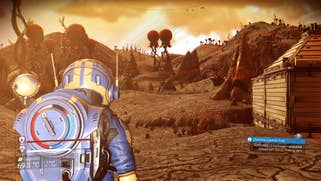
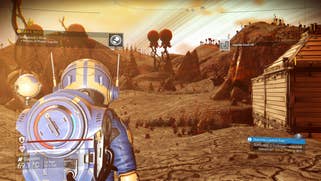


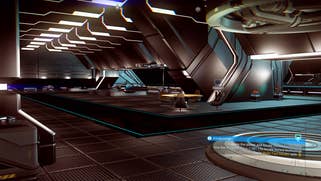

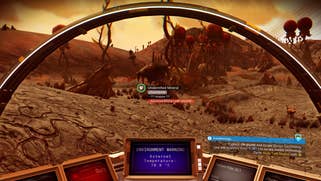







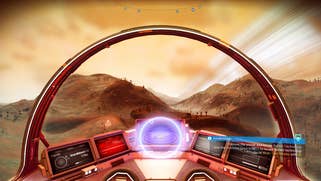

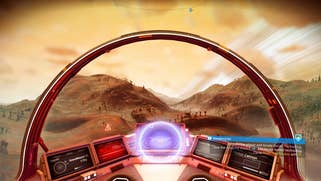
The quality mode offers the best-looking visuals for X users, simply by virtue of running at a true 3840x2160 resolution. It marks the first time No Man's Sky has ever run at a full 4K on console, and it pays off massively in letting you see far into the distance. All those fine details across a landscape - the mountains, trees and creatures - are all discernible from a great range. Quality mode is the way to go for the image quality purist and to make the most of it, you also get a few upgrades over the base Xbox One, including improved texture filtering, and further draw distances on objects and trees - though many texture assets appear identical. There's also a difference in ambient occlusion quality, faintly visible by eye, but otherwise the X hardware is mainly being pushed to a higher 4K. It's a significant bump from 900p in fact, a 5.7x increase that ranks as one of the biggest leaps in pixel count we've seen on X.
However, there is a drawback to all of this. While the 4K presentation is well worth experiencing, it pushes the machine to a point where even 30fps isn't sustainable. If you unlock the frame-rate, you'll see most planets play out at 30fps and above, especially in barren areas. Even so, there are cases where you get drops into the 20s, which triggers an adaptive v-sync if the 30fps cap is engaged. Landing on planets, firing lasers at thick jungle areas, or even walking around the very first space station triggers sub-30fps drops on Xbox One X at 4K, with tearing at the top of the screen too.
To remedy this, the performance mode drops the resolution to 2560x1440, and keeps most of the other settings in place from the quality mode. If we pit all three ways to play on Xbox One and X, this is the one to go for if you're after a solid frame-rate. Unfortunately, a consistent 60fps lock simply isn't possible on performance mode, and you'll likely encounter too many drops under that number to justify leaving the frame-rate cap off. Of course, there are simpler areas like the space hubs, which can run at 60fps, but mostly you'll see dips under that, with tearing too. Our recommendation would be to keep the 30fps cap enabled for a more consistent experience.
One curious point is that the 4K quality mode on X can perform worse than the regular Xbox One. The first space station is a great example; procedural generation is taken out of the equation, leaving a simplistic GPU test in a neon-lit hangar. This bogs down Xbox One X to a greater degree in matching runs, though thankfully where it actually matters - in exploring planets - the positions are reversed and the X takes the lead. Of all the ways to play, it's the regular Xbox One S that's most in need of improvement as things stand. Flying into a new planet triggers hits under 20fps, and while Xbox One X suffers from these stutters to a degree, it's a more regular occurrence on the base model - even on the ground.
Hello Games' transition to Xbox One hardware is otherwise a smooth one. Waiting has its benefits, and it means X owners in particular get the most richly featured version of No Man's Sky on day one of release. A true 60fps mode, at 1080p if needs be, would have been a plus here (assuming the CPU power is available) but those looking for a 4K showcase - with high dynamic range to boot - will be pleased with the results. Enthusiast forums have pointed out glitches and crashes remain - something we've yet to encounter in our first play-throughs - but clearly the Next update isn't the end of the road for this project. Even with its imperfections there's nothing else quite like it, and Xbox One users finally get to experience one of this generation's most fascinating titles.







